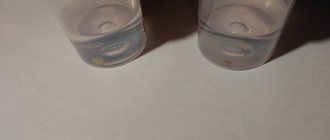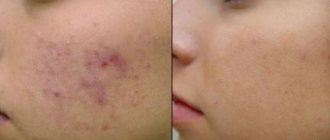AdminDiagnostics of papilloma Today, medicine knows more than 100 strains of the human papillomavirus (HPV). Some strains can lead to the development of such serious pathologies as precancerous and cancerous diseases of the cervix, cancer of the male genital organs, cancer of the pharynx and rectum.
Timely diagnosis of HPV plays a major role in the prevention of these diseases. The most common way to detect HPV is the Quantum 21 test.
Advantages and disadvantages
Kvant-21 is widely used in the diagnosis of HPV.
Advantages of the method:
- high accuracy – the reliability of the analysis results reaches 100%;
- speed of diagnosis - the patient learns the results of the analysis on the day the biomaterial is submitted;
- data on the concentration of the virus - allows you to assess the infectious load and the degree of influence of the virus on the patient’s immunity;
- The analysis allows us to identify the stage of infection with the virus and select individual treatment tactics.
Reference! The disadvantage of the method is its relatively high cost: analysis of Kvant-21 is almost 2 times more expensive than Kvant-15.
Reasons for appearance
Regardless of the type of HPV, there are common causes of this pathology:
- sharply reduced immune status (congenital or acquired);
- too early onset of sexual activity;
- casual sexual intercourse without the use of barrier contraception;
- chronic foci of infection in the body;
- frequent inflammatory diseases of the genitourinary system;
- endocrine pathologies;
- bad habits (alcohol abuse, smoking, use of drugs for non-medical purposes);
- therapy that suppresses the body's unwanted immune responses;
- numerous abortions;
- sexually transmitted diseases;
- long-term use of oral hormonal contraceptives.
Most often, a viral disease is activated when there is a clear decrease in the body’s immunity, when there is heavy physical or mental stress, and also if the body is in a constant state of stress.
Differences between HPV quantum-21 and quantum-15
The word "quantum" in the title of the study means number. Thus, Kvant-21 detects 21 types of papillomavirus, Kvant-15 detects only 15 types.
Kvant-21 examines a sample of biomaterial for the presence of strains: 6, 11, 16, 18, 26, 31, , 35, , 44, 45, , 52, , 56, , , , 73, 82. Only 11 and 44 types belong to to strains of low oncogenicity, other types have high oncogenicity.
Kvant-15 detects the presence of 15 HPV strains: 6, 11, 16, 18, 31, 33, 35, 39, 45, 51, 52, , 58, 59, 68. Only 6 and 11 strains do not belong to high oncogenic risk types .
Literature
- Prevention of cervical cancer: A guide for doctors. - M.: MEDpress-inform, 2008.
- Polonskaya N.Yu., Yurasova I.V., Sokolskaya T.Yu. Advantages and effectiveness of standardization of cytological studies in gynecology // Clinical laboratory diagnostics. - 2004. No. 11 p.47-50.
- Bekkers R., Meijer C., et al. Effects of HPV detection in population-based screening programmers for cervical cancer: a Dutch moment // Gynecol. Oncol. 2006; Mar: 100(3):451-4.
- Khan M., et al. The elevated 10-year risk of cervical precancer and cancer in women with human papillomavirus (HPV) type 16 or 18 and the possible utility of type specific HPV testing in clinical practice // J. nat. cancer inst. 2005; 97:1072-9.
- Snijders J., Meijer C. The value of viral load in HPV detection in screening // HPV today 2006; 8:8-9.
Preparing for analysis
The accuracy of the results depends not only on the qualifications of medical workers, but also on the correct preparation of the patient for submitting material for research.
The analysis should be taken during the period when new condylomas and papillomas appear on the body - this increases the possibility of obtaining the most reliable results.
Preparation rules:
- 3 weeks before the expected test, stop taking antibiotics, antiviral and other drugs. These medications affect the state of the microflora of the genital organs and can distort the test results.
- 3 days before collecting biomaterial, avoid sexual intercourse, including using a condom.
- The day before going to the doctor, stop using vaginal contraceptives, medicated tampons and ointments.
- Before taking tests, do not wash yourself with intimate hygiene products and antibacterial soap, do not take baths, and avoid douching.
- Do not empty your bladder 2-3 hours before the procedure - urine has an antibacterial effect and may affect the results of the study.
Before taking the test, it is not recommended to specifically give up alcohol and cigarettes (if used systematically) and switch to a strict healthy diet. Temporary changes in lifestyle reduce the reliability of the study.
Some doctors, on the contrary, advise the patient to drink a little alcohol some time before the test and include salty foods (smoked meats, sausages, beer snacks) in the diet to weaken local immunity.
Immediately after infection, the test results for papillomavirus will be negative. The study can be carried out no earlier than 3-4 weeks after the expected date of infection. See also the material on the topic: HPV type 16, quantitative analysis, decoding.
Important!
The test is not carried out during menstruation; the test can be taken 2-3 days after the bleeding has stopped.
Principle of examination
If you find the first signs of HPV on your body, contact a dermatovenerologist.
The danger of the virus is that it can exist for a long time without manifesting itself. The first signs include the presence of warts and papillomas (pointed in shape). This is followed by a decrease in immunity and disruption of the functioning of systems in the body.
If tumors are not removed under medical supervision, they can develop into a malignant tumor. The disease affects not only the skin, but also the mucous membranes.
Methods of infection with HPV
- unprotected sexual intercourse;
- infection of the child from the mother during childbirth;
- through damaged areas of skin when shaving.
Infection occurs in a gym or sauna through common objects. It is necessary to examine the body, and if papillomas or warts appear, consult a specialist.
Why is the analysis carried out?
Visually, the doctor will note growths on the skin, but will not be able to determine their nature; diagnostics are indispensable. The technique reflects the degree of damage to the human body by the virus and monitors improvements from treatment.
The laboratory determines the criterion of oncogenic danger:
- Papillomavirus of medium risk of activity. Manifests itself in the form of warts, condylomas, and verrucous epidermoplasia.
- Papillomavirus of increased risk of activity. Manifests itself in the form of carcinoma, bowenoid papulosis, and cervical neoplasia.
The examination results are highly accurate, and they can be obtained in hospitals within 24 hours. The indicators of the method depend on the preparation for the analysis.
| Basic indicators | HPV load | Possible risks |
| Up to 3 Lg (HPV/105) | Minor | No risk of degeneration |
| From 3 to 5 Lg (HPV/105) | Significant | The presence of dysplasia or the risk of occurrence |
| From 5 Lg (HPV/105) | Highly significant | Increased likelihood of dysplasia |
Material collection technology
To carry out the analysis, a sample of epithelial cells is taken from the walls of the cervix, cervical canal or urethra. In women, biomaterial is collected by a gynecologist, in men - by a urologist.
During the collection process and a day after the procedure, the patient may experience minor pain. If the pain continues for several days, you should consult a doctor.
Urethra
Before removing a sample for examination, the entrance to the urethra is disinfected and cleaned in the presence of purulent discharge. A sterile probe with bristles at the end is carefully inserted into the urethral cavity and the epithelial layer is removed. The resulting material is transferred to a glass slide and sent to the laboratory.
Cervical canal
Using a cotton swab, the surface of the vagina and cervix is cleaned of mucus and secretions and treated with saline solution.
An applicator with bristles at the end is inserted into the vagina and a small amount of epithelial cells is scraped off. The sample is immediately sent for testing.
Cervix
The algorithm for taking a sample for HPV testing from the cervix does not differ from the method of collecting biomaterial from the walls of the cervical canal. The main thing is to thoroughly clean the surface of the cervix from secretions.
Why is it necessary to periodically get tested for HPV?
Testing for HPV is recommended for patients who are diagnosed with papillomas during an examination, because it is important not only to identify the virus in the body, but also to determine its type and quantity at the time of HPV typing.
A positive DNA typing result in the absence of manifestations of the disease means that it is necessary to prevent the development of the virus. It is impossible to completely cure the papilloma virus, but with the help of modern medicine it is possible to reduce the activity of the virus for several years.
A scraping for HPV in women will help identify lesions that precede cancer at an early stage. If no changes are detected, then treatment is not necessary; the body is able to fight the virus itself.
A scraping for HPV can also be taken from the mucous membrane of the mouth, pharynx, nose, vagina, cervical canal, urethra, rectum.
Every woman after 30 years of age is recommended to take this test and repeat it periodically after 3-5 years.
Symptoms
Most often, HPV type 21 appears on those parts of the body that have been in contact with contaminated objects:
- hands, fingers, palms of the upper limbs;
- neck area;
- lips and nose area;
- feet and fingers of the lower extremities;
- belt where the skin comes into contact with the underwear.
Visually, warts look like dense growths formed by keratinized epithelial cells. They usually have a flesh color that is slightly lighter than the normal skin color. If you carefully examine the formation, you will notice black inclusions inside it, which are capillaries damaged by infection.
Warts are usually round in shape with smooth edges. They fit tightly to the skin and lack a stem. Adjacent skin does not show any changes. Such neoplasms do not cause pain. Some of them may disappear on their own after 1.5-2 years. But the pathology can also recur, indicating that the virus is still present in the body.
The main danger of HPV
The insidiousness of the papillomavirus lies in its long latent phase, when an infected person is not even aware of his condition and infects those around him. Those strains that have a high degree of carcinogenic risk (RCR) pose a particular danger to human health. Located on the genitals, they cause changes in healthy cells and provoke their degeneration into cancerous ones.
Many patients are not even aware of this possible outcome and consider papillomas, warts, and condylomas to be a common cosmetic defect.
It is important to know! This is especially dangerous for the female body. Many insidious viruses penetrate the genital mucosa. Located inside, they are invisible to a woman and can only be detected during a preventive examination or when the process has entered the final irreversible stage. A timely visit to a gynecologist will help identify the problem at an early stage and eliminate it.
How is it transmitted?
Infection with type 21 virus most often occurs through household contact. This may be direct contact with a carrier of a viral infection or with objects that have been infected with the virus. Outside the human body, the pathogen can exist for up to 3 hours. And after contact with the skin or mucous membranes, it penetrates through minor damage to their integrity. This happens especially quickly in places where profuse sweating occurs.
Often, the patient himself contributes to the spread of HPV elements throughout the body by touching the wart with a finger or palm that has damage. Human papilloma type 21 infection in women most often occurs due to unprotected sexual intercourse. Moreover, the risk increases significantly with frequent changes of sexual partners.
How to protect yourself from HPV
Unfortunately, it is not yet possible to destroy a virus that has already entered the body. The whole fight against it comes down to improving the body’s immune defense, as well as removing emerging papillomas using various methods. You can reduce the risk of infection if you exercise caution when visiting public places, and also use barrier types of contraceptives when having sexual intercourse with untested partners. However, there is a more reliable form of protection against the virus – vaccination. It is produced using the drugs Cervarix and Gardasil. Their difference from conventional vaccines is that they do not contain the viral infection itself, but are created based on the L1 protein. This compound has the ability to concentrate into viral particles, suppressing the development of infection in the body. The effectiveness of vaccination measures has been confirmed by clinical studies, which have shown that HPV type 21 cannot take root in women who have been vaccinated.
This virus is very insidious and if you do not contact a specialist in a timely manner, it can cause serious illness. Do not neglect your own health and delay diagnosis - the earlier the visit to the doctor, the faster and more productive the treatment.
What do the analysis results say?
People far from medicine would like to know what the letter and numeric values present on papers with research results mean. The test results may be as follows:
0-3 (HPV/105) – the viral load is insignificant from a clinical point of view;
3–5 Lg (HPV/105) – the viral load is more significant, there is a risk of dysplasia (pathological changes in tissue);
5 and higher Lg (HPV/105) – high viral load, and, as a result, a high risk of developing dysplasia.









